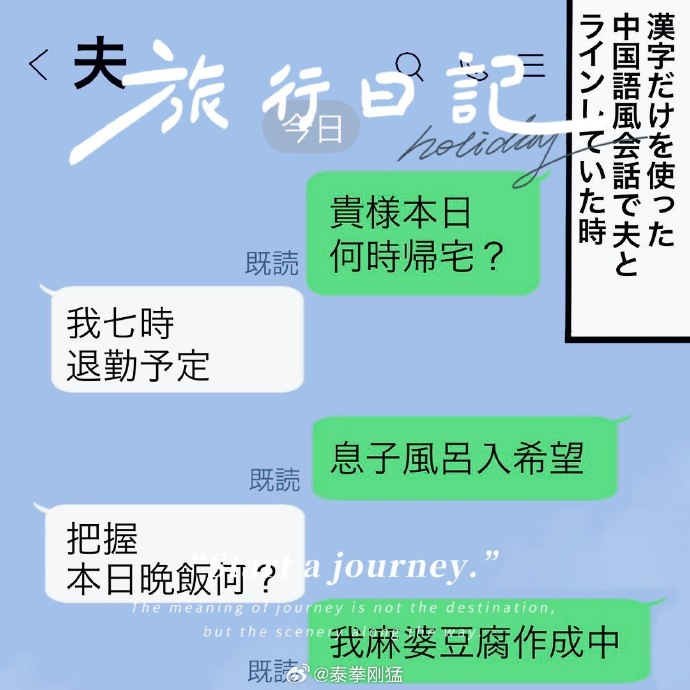Pseudo-Chinese conversation of a Japanese couple
« previous post | next post »
Screenshots from @泰拳刚猛 on Weibo:
The Japanese caption at the top right of the first image reads, "When I was texting with my husband in pseudo-Chinese using only kanji".
You can see that the exchange is completely kanaless, only kanji.
The couple are discussing quotidian affairs. The wife says she wants to make mápó dòufu 麻婆豆腐 ("Pock-marked Old Lady's Beancurd"), but then realizes she doesn't have any tofu at home. Horrors! What to do? The husband valiantly saves the day by saying he'll pick some up at a food shop on the way home. The wife warmly applauds. But then the husband says he'll be delayed getting home because of some leftover business at the office, so he won't be able to bring the tofu in time.
This Japanese couple must be having a lot of weird fun conversing in this whacky way.
I think any couple who are close to each other will naturally develop their own private language.
Incidentally, for what may be one of the best lexical, historical, and gastronomical accounts of mápó dòufu 麻婆豆腐 ("Pock-marked Old Lady's Beancurd") available anywhere, see the first item in the bibliography below.
Selected readings
"Wonton in Zanthoxylum schinifolium etzucc sauce" (5/6/15) — includes a very long explanation of mápó dòufu 麻婆豆腐 ("Pock-marked Old Lady's Beancurd")
"Sino-Nipponica" (7/26/15) — includes a discussion of the Japanese name for pufferfish.
If you do a Google search on "Language Log" and tofu, you'll find an abundance of entries, many of them quite curious and amusing.
[Thanks to Nathan Hopson]


Jonathan Smith said,
July 20, 2023 @ 3:57 pm
Holy shit truly hilarious when read in Chinese, 大拍手 indeed. However given syntax, perhaps this is better characterized as a pseudo-Japanese that results when limiting oneself to Kanji…
Victor Mair said,
July 20, 2023 @ 4:14 pm
Chūgokugo-fū kaiwa 中国語風会話 ("Chinese style conversation"), so the wife says top right.
Jonathan Smith said,
July 20, 2023 @ 9:24 pm
True the Japanese-side conception may be that there is something "Chinese-like" about leaving out particles/endings and representing all words in Kanji. And indeed certain formal vocab naturally reflects legitimately Chinese syntax (fuka 不可, yosōgai 預想外…)
My thought was (1) (sentence-level) syntax is uniformly Japanese and (2) vocab also can only be interpreted as Japanese — among words represented with two characters, there are many instances that exist in Japanese not Chinese, none vice-versa (zangyō 殘業 being one of many examples — 'overtime' not just 'leftover affairs/work' as readers of Chinese might [might] surmise.) Then of course the items that readers of (just) Chinese can't understand period… 貴樣 / 風呂 / 味噌汁 / 齊 etc. etc…
At any rate funny stuff… in particular from the Chinese side e.g. 本日晚飯何?, 我豆腐購入可, are understandable but seem both super stilted and to have been through the blender…
(sorry for all traditional Chinese not Japanese characters above…)
Brian O'Connor said,
July 23, 2023 @ 1:55 pm
Out of interest, would a competent Japanese reader be able to make sense of this?